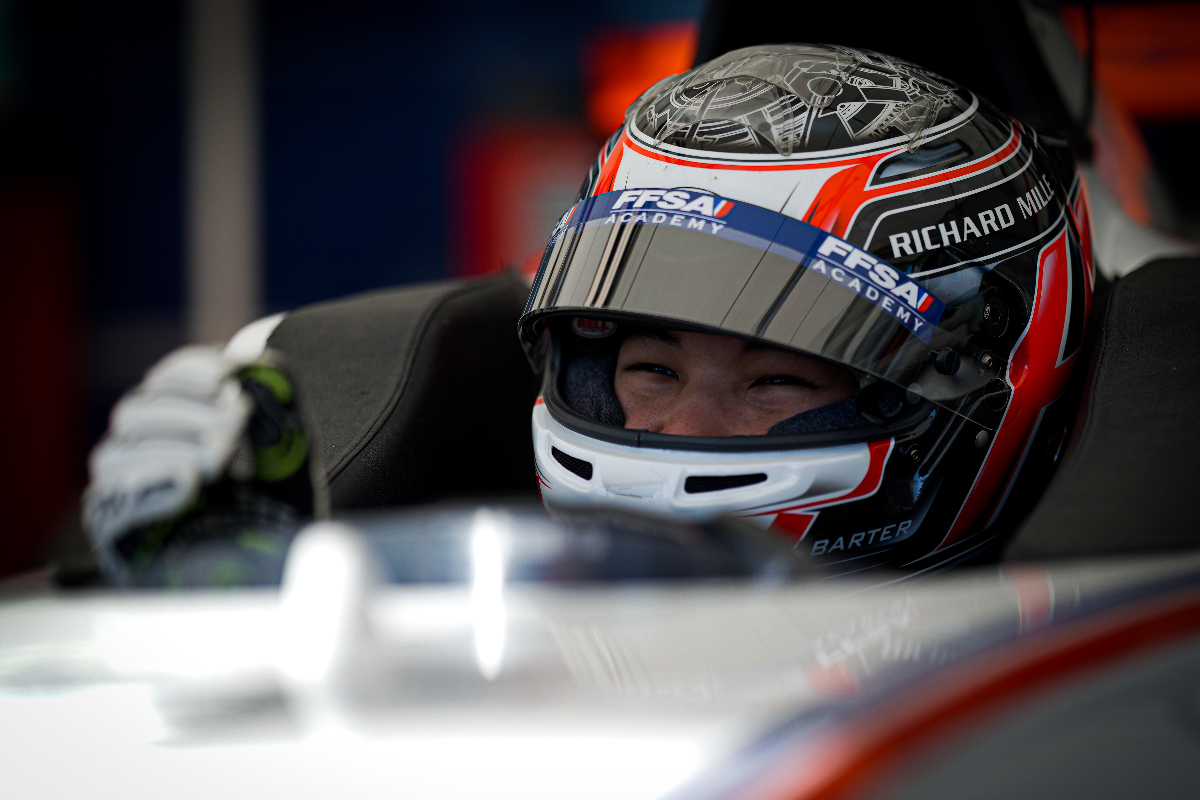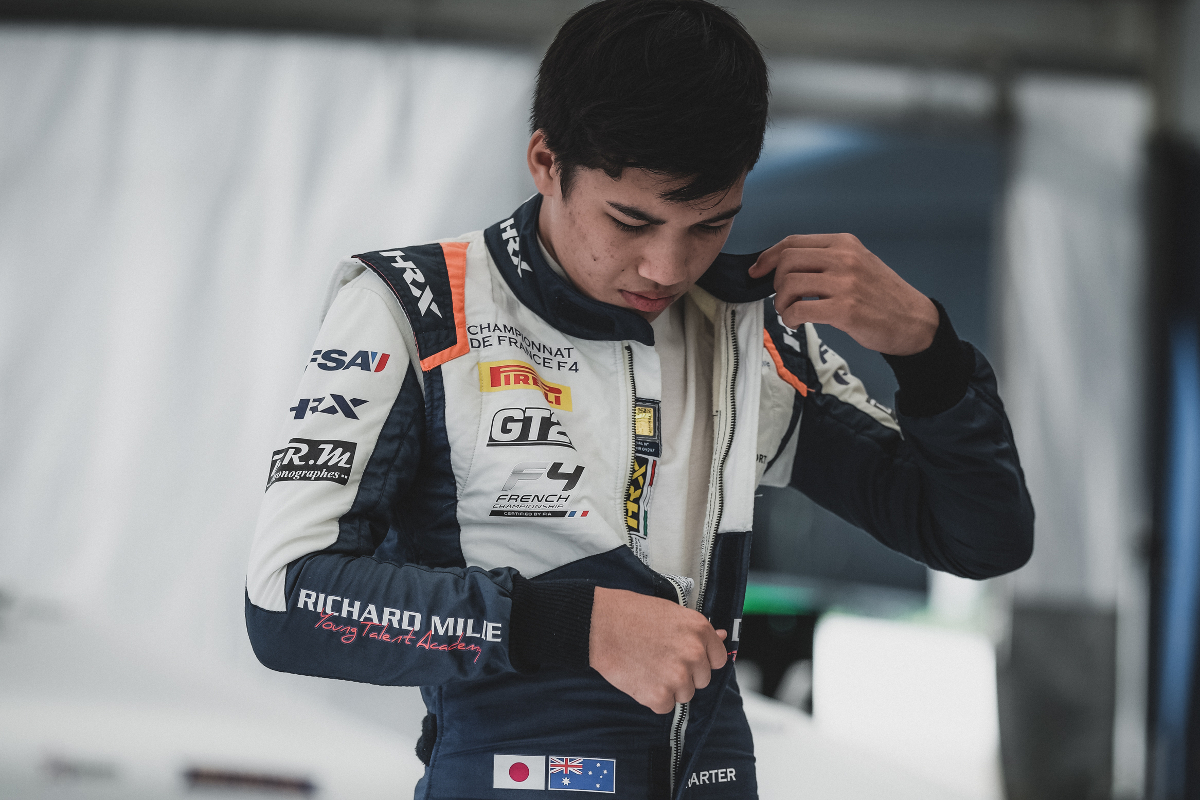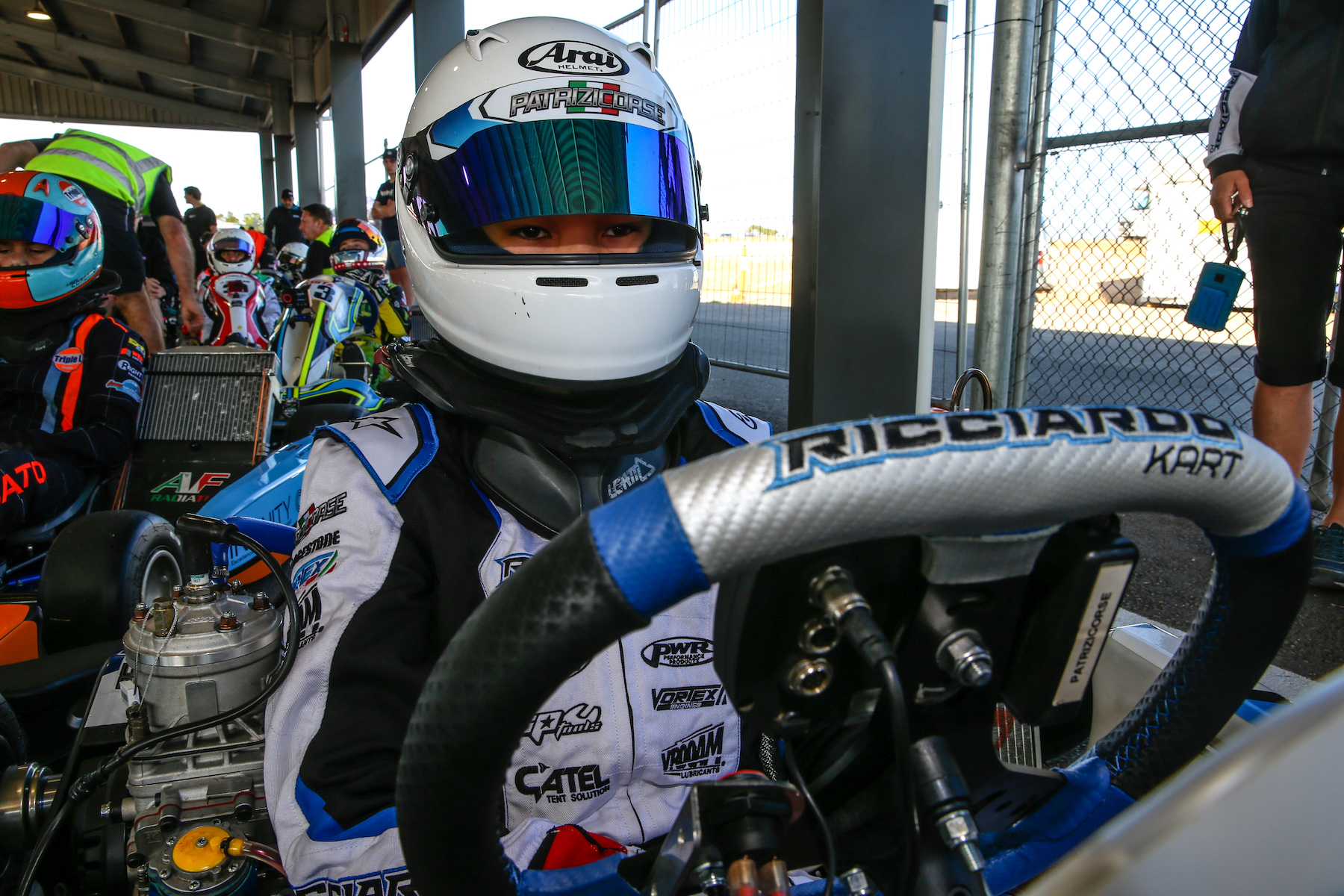
Photo: KSP Reportages
Rather than graduating to Formula Regional like his 2021 rivals, French F4 runner-up Hugh Barter has taken the bold decision to stay in the series and go for the Spanish F4 title in his second season in single-seaters
As one of the title favourites in French Formula 4 this year, Hugh Barter knows that he needs to deliver.
“The ultimate goal this year is to win both championships. It’s not going to be easy, but that’s the goal,” says the Australian-Japanese driver.
Formula Scout caught up with Hugh, and his father Chris, between pre-season tests to chat about his goals for 2022.
Both of Barter’s title rivals, Esteban Masson and Maceo Capietto, and fifth-placed Owen Tangevalou will step up to FRegional European Championship this year, and that was his “original plan”. But a discussion with another driver’s father raised the question: “If you can’t win, why would you go up?”
As always in motorsport, finding the budget for the next rung on the ladder is far from easy, and so “doing two series at the same time at the same cost instead of going up a class to FREC is a really good option” says Barter, who has added a Spanish F4 campaign to his second season in France.
But he stresses that it is seat time rather than cost which was the main factor in deciding to embark on a gruelling 42-race dual campaign.
Barter’s father added: “We thought Hugh was underprepared for last year and if we can do two series, he’ll get a lot more seat time, get more experience, be a lot more confident and then when he does step up that’ll just make it easier for him.”
The French and Spanish F4 calendars dovetail nicely with no clashes apart from a couple of test days, although clearly the logistical effort in travelling back and forth across the Pyrenees and arranging accommodation will be sizeable.

Photos: Chris Barter
Ollie Bearman demonstrated in 2021 that double title success is possible in F4. But there is a huge difference between Bearman’s dominant success and what lies ahead of Barter. Bearman was able to compete in ADAC and Italian F4 with the same team, Van Amersfoort Racing, and crucially in the same car.
Barter will, however, need to build a working relationship with two different sets of engineers: French F4 is centrally run by FFSA Academy, and in Spain he will be run by Campos Racing who he has been getting acquainted with in readiness to race. French F4 also differs by adopting Mygale’s second-generation car for 2022, while in Spain it is a Tatuus chassis being used.
“I’ve been doing some simulator work with Campos learning the tracks so even though it’s a different car it gives me a rough idea. You know where the track goes.”
On how the idea to go to Spain came about, he adds: “We’d already started talking to somebody at All Road Management [which is involved in the Richard Mille Young Talent Academy shootout that Barter won in 2020] about our decision to maybe do two of them and an introduction was done. We started talking about the dual series at Paul Ricard, so it’s been a long discussion but contracts weren’t signed until recently.
“Both championships were concerned about are we taking them seriously and so there’s been some sort of talk about that we weren’t taking this series properly, which is not true. We want to win both of them.”
Barter is aware of the added challenges of switching between a Renault-powered Mygale M21-F4 on Pirelli tyres and a Abarth-powered Tatuus T-421 on Hankooks, but his initial experience of the cars has not given him reason to be worried.
“Obviously there’s going to be some sort of challenge to it. It’s definitely not going to be easy. But I don’t think there’d be too much of a struggle.
 “Towards the end of last year we did a test at Barcelona in the Tatuus, the old one, and it seemed quite well. I’d never driven the car before, never been at the track before and never driven on the tyres before. And I think at the end of the weekend, I set the second fastest lap so on the adaptability side of things, it should be quite good.”
“Towards the end of last year we did a test at Barcelona in the Tatuus, the old one, and it seemed quite well. I’d never driven the car before, never been at the track before and never driven on the tyres before. And I think at the end of the weekend, I set the second fastest lap so on the adaptability side of things, it should be quite good.”
After initial running in Mygale’s Gen2 car, Barter is impressed with the changes: “It’s quite a nice car to drive feeling-wise. It’s faster in a straight line, it’s got more kick to it and more power under the right foot, so it’s quite enjoyable to drive.”
On the downside the new car is, in Barter’s view, “a little bit more lazy”, particularly through slower corners where it “tended to take longer to rotate [as] the car’s a bit longer, the centre of gravity is a bit higher because of the halo so it’s just a given from the way the car has changed from last year”.
Having now sampled the Gen-2 Tatuus chassis as well, how does he compare the offerings of the rival manufacturers?
“The two cars are quite different this year. The Mygale is a very calm and controlled car while the Tatuus is a bit more challenging with the different tyre compound, but in the end I think both cars have changed by quite a margin from the previous generation and for the better.
“Both cars are fairly similar in the high-speed corners but the biggest difference is under braking and slow corners where the Mygale is a lot more settled with fewer corrections needed while the Tatuus seems to be a bit easier to lock up and difficult to carry minimum speed.”
Barter accepts that the different tyres could be a significant factor in the two chassis’ handling characteristics. And in fact, the tyres have required the biggest adjustment in his driving style.
“The Pirelli is a lot softer tyre than the Hankook and so through the slow section you can lean on the Pirelli a lot more.
 “You can put a lot more lateral weight on it and load and so, for example, at the last chicane at Barcelona the Hankook was just more lazy, more tended to four-wheel slide and so you had to be more patient on the Hankook through there.”
“You can put a lot more lateral weight on it and load and so, for example, at the last chicane at Barcelona the Hankook was just more lazy, more tended to four-wheel slide and so you had to be more patient on the Hankook through there.”
Barter goes into 2022 with two car racing wins to his name, one of which came in his debut race weekend at Nogaro. The circuit will also be venue for round one of French F4 this year during its traditional Easter weekend meeting.
After the Nogaro win, Barter struggled to maintain the pace to be at the front. By his own admission, round three at the Hungaroring was “shocking” with a best finish of seventh, while next time out at Ledenon he made the podium but “some minor mistakes here and there, like starts and stuff like that, were quite punishing”.
There was only more podium in the next two rounds, before he appeared at the front again in the Magny-Cours season finale with a second place and a win which put him second in the points as Capietto was disqualified from the weekend.
“Through the season, the things that I lacked were just seat time and experience and trying to know what to do in certain situations. Confidence is the main thing that I’ll have this year that I didn’t quite have last year.”
Does he, however, agree that his early success went to his head a little, causing some complacency?
“I think after having the win in the first round, the expectations changed completely for the whole year,” he acknowledges.
Coming into 2021 with just two test days of experience meant initial expectations were low, but “obviously after the first round we had a good shot to fight for the title and so after the round expectations changed from not knowing anything to winning the championship”.
Despite emerging as the championship runner-up – and within points, after dropped scores, of champion Masson in the FIA classification where there were no bonus points for poles or fastest laps – Barter is clearly disappointed with how his rookie season turned out: “There were no poles, there were only two wins.”

Barter #68
His inability to qualify on pole (with an average starting position of 4.64 and six front rows) was, in his view, fundamental, “because you can have all the race pace you want but if you’re not on pole your life becomes suddenly a lot harder to win a race, especially as the French tracks, like Ledenon or Nogaro, are not the easiest to pass at. So yeah, it’s quite critical in the French series to qualify on pole and get a good start.
“The only track last year where you could get away with starting back was Monza. Monza was going really well. Until race one…!”
A lap one collision forced his retirement from that race and put him at the back of race two’s grid, but he recovered to sixth. Race three’s cancellation due to wet weather meant he couldn’t claw back points as he was due to start on the front row.
“So I think after that it was going to be really tough to win the championship… so I was just doing the best I could in those last two rounds.”
In the penultimate round at Paul Ricard, Barter qualified eighth “but the races were really good” as he recovered to fourth and third in races one and three. Barter came out on top of a thrilling battle with Capietto for his race three podium.
“That was a really good weekend. Finally, some actual side-by-side racing. You don’t get this so often in F4 compared to karting. That was fun and some more experience that I could take away from the year into this year.”
A return visit to Magny-Cours, the only circuit the series visited twice, demonstrated to Barter his progress over the season, and ended with victory in the season finale, albeit only after rivals Masson and Capietto had eliminated each other on track.
Barter’s motorsport journey began at the Australian Grand Prix, after the family moved to Melbourne from Nagoya, where he had been born.
“I took him to the Grand Prix,” remembers Chris, “and his eyes lit up and he was two years old. A couple of years later, on the way to a V8 race, there was a simulator, and Hugh begged me to get on there and I said ‘but you’re too small’.

“And he had this cry and it wasn’t like a whingeing cry. It was like someone had stabbed him in the back. So, I said to the guy ‘look, if I do the pedals can he steer’. Anyway, so he’s doing Bathurst and I think he crashed twice going around and did like four or five laps and he was doing good pace and the guy was like really impressed.
“So, we bought him a simulator and he lived on it for two years. He’d come home from school and he’d sit on it and then he was just always on it. We had to drag him away from it.”
When Barter was five, the family picked up “a trailer, a go-kart, an engine, a racesuit and a helmet for, like, 5000 Australian dollars [and] from that moment, every weekend we were at a go kart track.”
The family’s best efforts to wean him away from karts and onto less expensive hobbies, such as playing the cello or tennis, were all in vain.
Barter’s move into cars, and the decision to uproot the family and move to France, came after he won the third edition of the Richard Mille Young Talent Academy shootout in October 2020, with its prize of a fully-paid season in French F4.
“We were always thinking of coming to Europe and doing single seaters last year,” Hugh says. “That was my last year in junior karting in Australia and we didn’t want to go to seniors in Australia, so that was always the plan, but it was just something to push us to help us.
“The prize was just, let’s say, the cherry on the cake. It’s definitely something that made our lives a lot easier and made a smoother transition from karts to single seaters. And I think the French championship was a really good entry to single seaters. Everyone’s data are shared, and it was a really competitive season with Esteban and Maceo, and a good learning curve.”
The opportunity in Europe had come about through Barter’s performances for Australian Birel ART importer, Patrizicorse – established by former Prema Formula 3 driver Michael Patrizi and the official factory team for Daniel Ricciardo’s Ricciardo Kart.
So, did the F1 star pass on any tips to his young compatriot?

“Unfortunately not,” laughs Barter, “but I did get a surprise phone call from him after coming back to Australia from the shootout, which was quite nice and you know, him following along was a nice surprise to have.”
Moving to France meant adjusting to a new environment, not only for Hugh but also his parents. As Chris explains: “We moved over from Australia and then we had to learn how it all worked in Europe. Work out where Hugh fitted in and how he could operate here. Could we stay here? Was it worth the pulling up the family and moving over here? We didn’t commit to buying anything. So, we didn’t know where he was going to fit in. So, there was a lot of what-ifs and hows. And obviously, as the year progressed, he got better and better.”
And, of course, the developing COVID-19 pandemic imposed huge restrictions on international travel. Returning to Australia after winning the Richard Mille shootout meant a two-week mandatory quarantine. “We got out of quarantine on the Friday morning at 4am, flew to Newcastle which is a go kart track near Sydney, then drove two hours to the track, signed in at 10am and got in the car for practice and then qualified the next morning and then raced.” The family hasn’t returned to Australia since “because we didn’t want to risk it”.
Settling in France was, however, surprisingly easy, apart from “the paperwork and all the admin. But the people have been absolutely lovely,” says Chris. At the track, Hugh hasn’t encountered any problems. “Driver briefings are in English. Some of the mechanics don’t speak English but because I’m Australian they usually pair me up with a bilingual mechanic and that makes things easier. It was really good last year.”
Initially, the family were based near to the Academy in Le Mans, but “we’ll move to the south of France to near Beziers or Montpellier. It’s closer to Spain and also most of the tracks in France are down south like Pau, Paul Ricard and Ledenon.”
From there, Barter will be one to watch whichever side of the Pyrenees he’s competing this year.